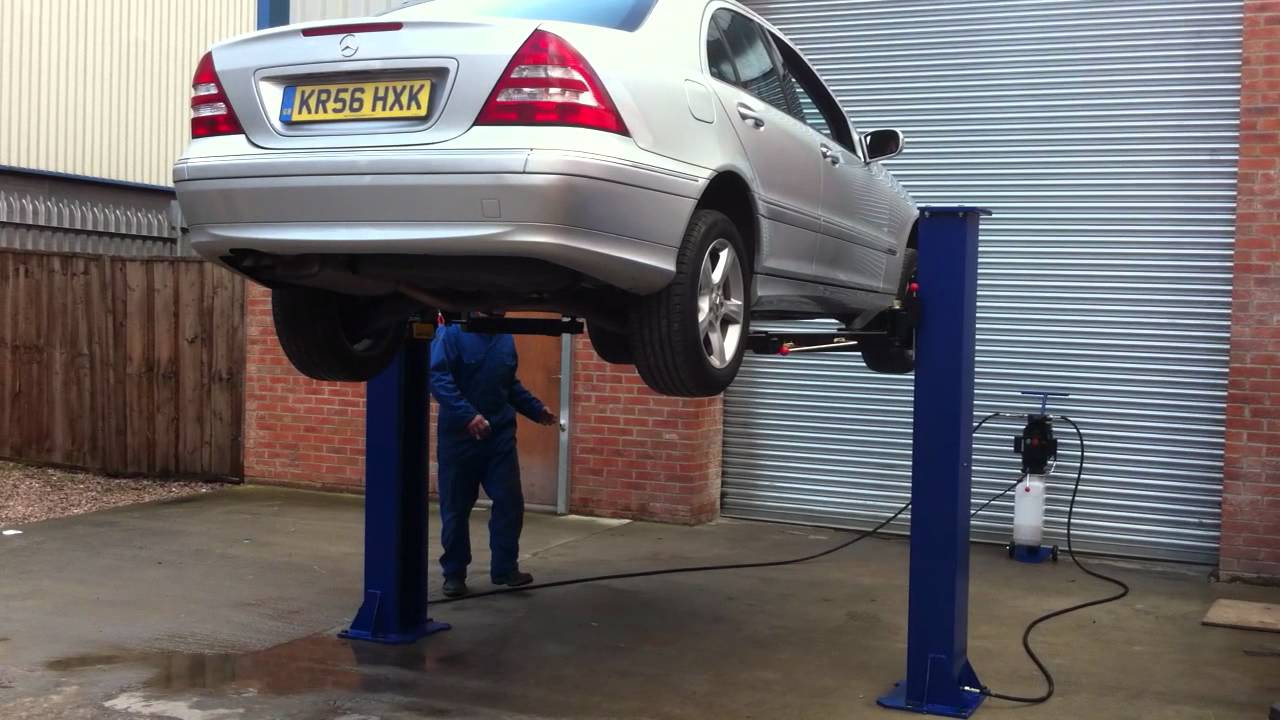Post lift
A post lift is a lifting device which is typically used to raise vehicles inside buildings for easy repair and maintenance access. Most post lifts are above ground, but there are also in-ground varieties.
Contents |
[edit] Two post lift
This is the most commonly-used type of post lift. It consists of two upright columns, four adjustable arms attached to a carriage assembly, and two hydraulic cylinders. It is usually mounted to an existing concrete structure, at least 4 inches thick. Most are powered by an electric/hydraulic power unit.
The power unit delivers pressurised hydraulic fluid to the cylinders. A set of equalisation cables is installed between the carriages to ensure that all four arms move together. Automatic safety arm locks are designed to secure the lift arms, once the arm pads have been properly positioned under the vehicle.
[edit] Four post lift
This type of lift allows the vehicle to be driven onto two runways and lifted by its tyres. The advantage of this lift is that their is full access to the underside of the vehicle.
[edit] Drive-on parallelogram
This is a drive-on lift with two runways. The lifting mechanism can move the vehicle a short distance when lifting or lowering; or it can simply be lifted straight up and down. The two parallel runways are usually synchronised by hydraulic or electronic means; sometimes with a torsion bar connected to opposing legs.
[edit] Scissors
Surface-mounted and in-ground scissor lifts are available; either as a drive-on with runways or frame/body-engaging. It is similar to a parallelogram lift but raises and lowers the vehicle in a straight vertical path.
[edit] In-ground lift
This type of lift has its assembly installed below the concrete floor. One or more hydraulic pistons or scissors mechanisms can be used depending on the weight to be lifted.
[edit] Wheel engaging mobile units
Also known as a mobile column lift, this consists of individual lifting columns used in sets of 2, 4, 6, or more units. Each individual column is mobile and contains an electric power unit. Cables or wireless technology is used to synchronise the column lifting and lowering.
[edit] Related articles on Designing Buildings Wiki
Featured articles and news
The UK's Modern Industrial Strategy: A 10 year plan
Previous consultation criticism, current key elements and general support with some persisting reservations.
Building Safety Regulator reforms
New roles, new staff and a new fast track service pave the way for a single construction regulator.
Architectural Technologist CPDs and Communications
CIAT CPD… and how you can do it!
Cooling centres and cool spaces
Managing extreme heat in cities by directing the public to places for heat stress relief and water sources.
Winter gardens: A brief history and warm variations
Extending the season with glass in different forms and terms.
Restoring Great Yarmouth's Winter Gardens
Transforming one of the least sustainable constructions imaginable.
Construction Skills Mission Board launch sector drive
Newly formed government and industry collaboration set strategy for recruiting an additional 100,000 construction workers a year.
New Architects Code comes into effect in September 2025
ARB Architects Code of Conduct and Practice available with ongoing consultation regarding guidance.
Welsh Skills Body (Medr) launches ambitious plan
The new skills body brings together funding and regulation of tertiary education and research for the devolved nation.
Paul Gandy FCIOB announced as next CIOB President
Former Tilbury Douglas CEO takes helm.
UK Infrastructure: A 10 Year Strategy. In brief with reactions
With the National Infrastructure and Service Transformation Authority (NISTA).
Ebenezer Howard: inventor of the garden city. Book review.
The Grenfell Tower fire, eight years on
A time to pause and reflect as Dubai tower block fire reported just before anniversary.
Airtightness Topic Guide BSRIA TG 27/2025
Explaining the basics of airtightness, what it is, why it's important, when it's required and how it's carried out.
Construction contract awards hit lowest point of 2025
Plummeting for second consecutive month, intensifying concerns for housing and infrastructure goals.
Understanding Mental Health in the Built Environment 2025
Examining the state of mental health in construction, shedding light on levels of stress, anxiety and depression.






















